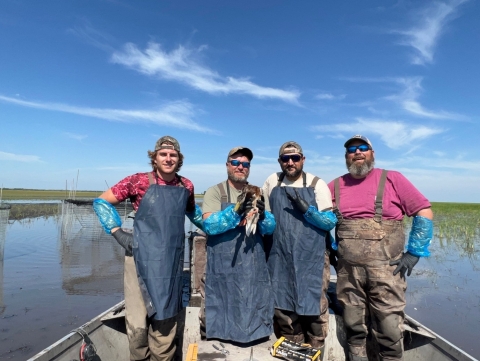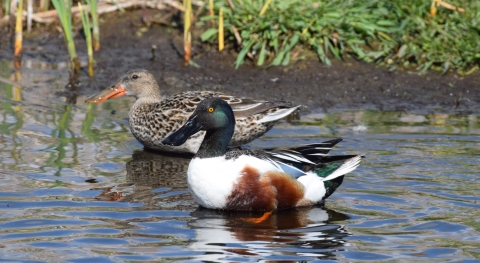The days and nights were getting noticeably colder in southern Manitoba and bird banding was coming to an end. We had a tremendous month of capturing and banding ducks. After talking with locals and taking a first glance at the marsh, it was evident that high marsh water had actually created extensive molting habitat (where birds can replace their wing feathers) and that attracted a rich diversity of waterfowl to the area. Grebes, bitterns, avocets, ibis, shorebirds, and raptors also filled the marsh. By the time we pulled the duck traps from the marsh, we caught a variety of waterfowl including mallard, black duck, ruddy duck, northern shoveler, pintail, gadwall, redhead, canvasback, wood duck, blue-wing teal, ring-necked duck and green-wing teal. Over 3,100 mallards received a bird band and we broke our veteran crew leader Stephen Chandler’s record!
The bird banding crew consisted of USFWS biologists, Byron Mitchell and Sean Sweeney, and our crew leader, migratory bird biologist, Stephen Chandler. This was my first year as a volunteer. Since Sean and I were new to bird banding, the veteran experience and encouragement from Byron and Stephen along with their patience helped us learn quickly. I learned about the cyclic and seasonal natural waterfowl behaviors and the physical attributes specific to waterfowl, commonly referred to as phenology and morphology, on a multitude of waterfowl species along with the ability to identify the age and sex of the birds. We also got plenty of practice capturing and banding ducks.
The weather throughout the month shifted between beautiful sunny days to rolling prairie thunderstorms. The latter at times affected our bird banding efforts by keeping us off the marsh and changing the ducks’ behavior. High water made the usual big grass habitat bird trapping zones too deep for dabbling ducks since they typically prefer shallow waters as they tip their bodies up to eat rather than dive in deep water for their food. Instead, we focused our efforts on flooded fields and shallower water on the periphery of the main marsh accessed by a combination of an airboat and truck. All in all, we had 17 swim-in traps baited with local barley. The duck traps were full and at times we were banding 250+ mallards a day!
The local community, the knowledge and effort of the bird banding crew, and the subtle beauty of the marsh made my first bird banding experience a memory I will never forget. I am grateful for the opportunity to volunteer and be part of the bird management efforts for the Western Canada Cooperative Banding Program in Manitoba. Until next time southern Manitoba!








